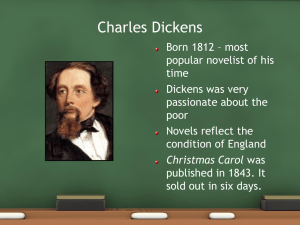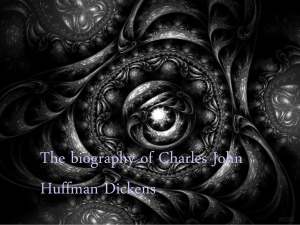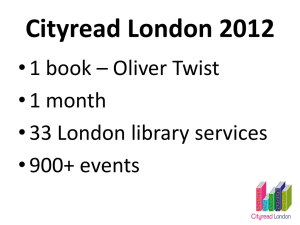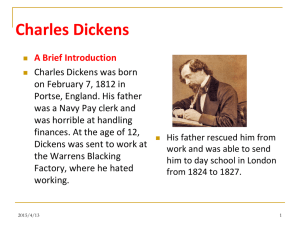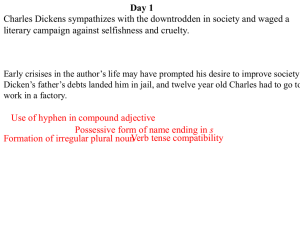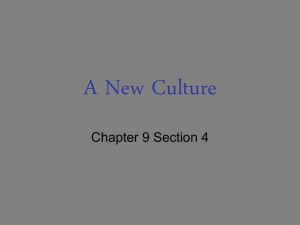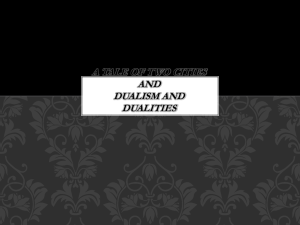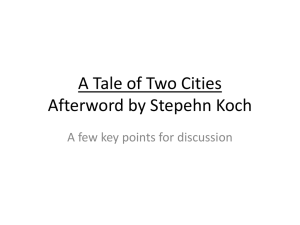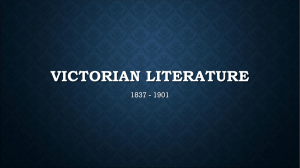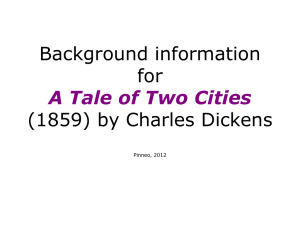File
advertisement
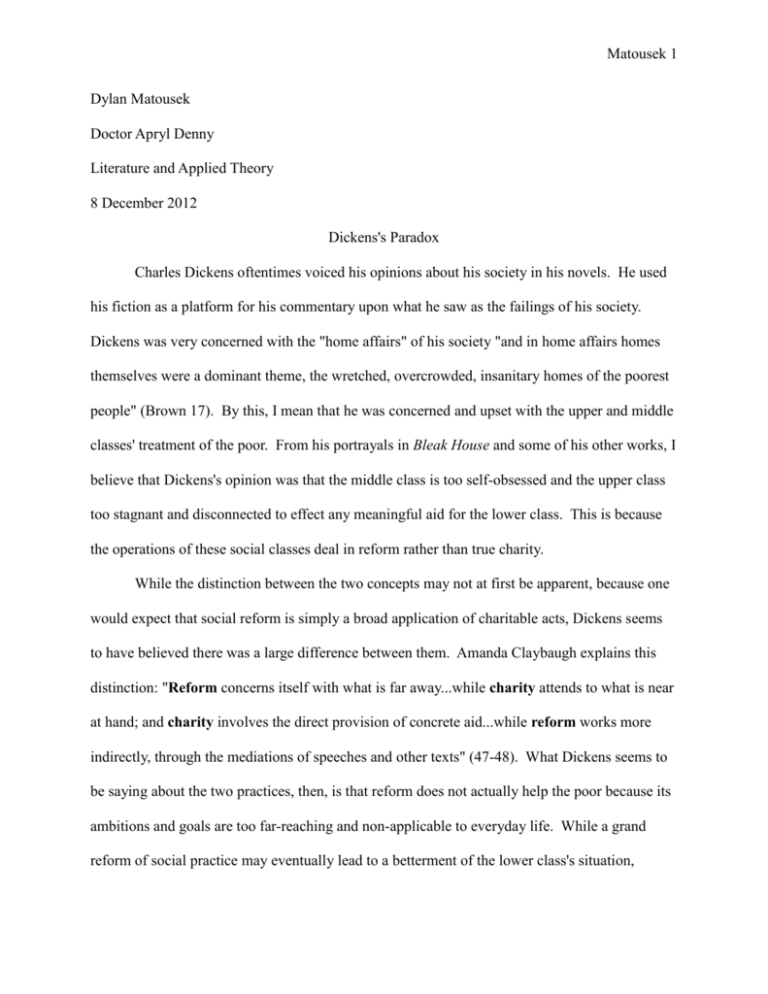
Matousek 1 Dylan Matousek Doctor Apryl Denny Literature and Applied Theory 8 December 2012 Dickens's Paradox Charles Dickens oftentimes voiced his opinions about his society in his novels. He used his fiction as a platform for his commentary upon what he saw as the failings of his society. Dickens was very concerned with the "home affairs" of his society "and in home affairs homes themselves were a dominant theme, the wretched, overcrowded, insanitary homes of the poorest people" (Brown 17). By this, I mean that he was concerned and upset with the upper and middle classes' treatment of the poor. From his portrayals in Bleak House and some of his other works, I believe that Dickens's opinion was that the middle class is too self-obsessed and the upper class too stagnant and disconnected to effect any meaningful aid for the lower class. This is because the operations of these social classes deal in reform rather than true charity. While the distinction between the two concepts may not at first be apparent, because one would expect that social reform is simply a broad application of charitable acts, Dickens seems to have believed there was a large difference between them. Amanda Claybaugh explains this distinction: "Reform concerns itself with what is far away...while charity attends to what is near at hand; and charity involves the direct provision of concrete aid...while reform works more indirectly, through the mediations of speeches and other texts" (47-48). What Dickens seems to be saying about the two practices, then, is that reform does not actually help the poor because its ambitions and goals are too far-reaching and non-applicable to everyday life. While a grand reform of social practice may eventually lead to a betterment of the lower class's situation, Matousek 2 reform overlooks the immediate needs of that lower class. Charity, on the other hand, seeks to better the lower class's immediate situation. The belief of Dickens's that the upper and middle classes are not helping the poor as they should be can be seen at work in his portrayal of certain characters in the novel Bleak House. He presents Sir Leicester Dedlock as the personification of the stagnancy of the upper classes, Mrs. Pardiggle and Mrs. Jellyby as representatives of failed and misguided philanthropy (reform), the industrious Mr. Rouncewell as the rising middle class, and poor young Jo as the embodiment of the hopelessly forgotten lower class. Taken together, all of these representations paint a picture of Dickens's view regarding the necessity of action to be taken on the part of the poor but that that action is forgotten, evaded, or done in a misguided manner by those who are responsible for undertaking it, the upper and middle classes. To begin, then, let us examine Dickens's portrayal of the stagnant, decaying, and disconnected upper class. He presents to the reader his personification of the upper class in the character of Sir Leicester Dedlock. While Sir Leicester isn’t actually aristocracy, being only a baronet, he stands in as the representative of gentry and aristocracy. Sir Leicester is immediately associated with language of stagnancy and resistance to change. Dickens describes him as “an honorable, obstinate, truthful, high-spirited, intensely prejudiced, perfectly unreasonable man” (68). His intense prejudices are against all things new and he considers the upholding of family name and tradition in the highest regard. The decay of the upper class is represented in the buildings which they inhabit. Dickens presents “Chesney Wold as the decaying fortress of the aristocracy” (Kelley 254). This, Alice van Buren Kelly points out, is seen in the abundance of wetness which is associated with Chesney Wold aligning it with “the process of slow, damp decay” (254). All this dampness and Matousek 3 decay is pushing Chesney Wold, and the upper class who reside there, closer and closer to the grave. Indeed, “there is a general smell and taste as of the ancient Dedlocks in their graves” (Dickens 68). Sir Leicester’s disconnection from the struggles of the lower class can be seen in his near complete lack of interaction with any characters representative of that class. There are no scenes in the novel in which Sir Leicester interacts with Jo. He only ever takes a passing interest in Rosa, though she is not portrayed as really representing the downtrodden poor. His chief concerns throughout the course of the novel seem to be the state of his family, the state of his marriage, and his concern regarding the rise of the middle class into parliamentary proceedings. Not once does he deem to stoop so low as to take notice of the poor. By keeping Sir Leicester entirely separated from the world of the poor, Dickens may be commenting on their disconnectedness and its effects on their attempts to help the poor. In other words, the upper class cannot bring about any meaningful improvement for the lives of the poor because they never see them. Moving forward, then, let us examine Dickens’s portrayal of the self-obsessed middle class. Mr. Rouncewell, the “Ironmaster,” seems to me to be the primary figure representing the industrious, rising middle class. Amidst all his industry, though, Mr. Rouncewell seems to have little time for anything else. He is present in the novel for only a very short amount of time. He confides to Sir Leicester and Lady Dedlock that “in these busy times, when so many great undertakings are in progress, people like myself have so many workmen in so many places, that we are always on the flight” (Dickens 376). This seems to indicate the all-consuming nature of his work. To further support that idea is his renunciation of his seat in parliament (Dickens 375). Taken together, these two ideas indicate to me that he is representative of Dickens’s view of the Matousek 4 self-obsessed nature of the Victorian middle-class. Mr. Rouncewell has time only for the furthering of his “great undertakings” as they pertain to him. He has no time to sit in parliament and attempt to enact undertakings from there. This relates to my idea of the middle-class’s failings to assist the poor. If the middle-class cared more about their duties to assist those who are unable to enhance their situation, perhaps they would spend more time setting aside their personal gains to enact some gains for the poor. This idea is supported by a declaration from Dickens himself. “Shortly before writing Little Dorrit, Dickens declared that ‘our political aristocracy and our tuft hunting are the death of England,’ a judgement that implicates both upper and middle class” according to Rodney Stenning Edgecombe (283). He goes on to cite Katherine Retan as noting “how [Dickens] ‘becomes less optimistic about the ability of the middle class which he has begun to see as morally bankrupt, as guided solely by the principles of political economy to alleviate social distress’” (283). This supports my claim of Dickens portraying the middle class as unable to help the poor as they are supposed to; in other words, unable to govern effectively and act morally towards them. The last character who represents a facet of English society that I would like to address is Jo. Jo is, in my opinion, the greatest appeal to the reader’s emotion made in this novel. He is Dickens’s attempt to sway the reader’s emotions to action on the part of the poor. The description of the place where Jo lives, or as Dickens writes “has not yet died,” is a vivid depiction of the base squalor and degradation that is the daily life of England’s poorest (239). Dickens describes Tom-All-Alone’s as “a black, dilapidated street, avoided by all decent people” (239). He goes on to say that “these tumbling tenements contain, by night, a swarm of misery…sowing more evil in its every footstep than…all the fine gentlemen in office…shall set right in five hundred years – thought born expressly to do it” (239). This is a not-so-subtle jab at Matousek 5 the upper and middle classes, who comprise the body of parliament, and their failure to address the English poor. The members of parliament, in Dickens’s eyes, are failing in their express purpose of helping society. He says that, even if given five hundred years, the members of parliament will never cure the problems of the poor. Dickens pushes his criticism further when he describes the scene in which Jo dies. He gives the reader an emotionally charged scene with Jo repeating the words of the Lord’s Prayer until his strength finally fails and he passes (574-575). He finishes the scene, and the chapter, with a very clear and concise indictment of all those who failed to help Jo, and the poor he represents. Dickens writes: “Dead your majesty. Dead, my lords and gentlemen. Dead, Right Reverends and Wrong Reverends of every order. Dead, men and women, born with Heavenly compassion in your hearts. And dying thus around us, every day” (575). This scene is what initially led me to believe that Dickens blamed the upper and middle classes for the situation of the poor. He steps outside of his narrative for just this instance in the whole of the novel. He speaks not as a narrator, but as himself when he says describes the poor as dying around “us.” Dickens adds even more weight to this already emotionally charged scene with his clipped, repetitive sentence fragments. He repeats “dead” at the beginning of each, and with each successive fragment he names each party who is responsible for causing the state of Jo’s wretched life. Now that we see Dickens’s representations of the different social classes in Victorian society, let us move into his representations of the reasons for the failure of the upper and middle-classes to help the poor as they should. First, let us address Dickens’s portrayal of the philanthropic institutions. The goal of these institutions is supposedly to help the poor and better their station in life, but Dickens seems to believe that they fall drastically short of this objective. Matousek 6 The institution of philanthropy is personified by the characters of Mrs. Pardiggle and Mrs. Jellyby. Dickens’s views on the matter can become immediately apparent with his titling of the chapter introducing the matter “Telescopic Philanthropy” (88). Such a title casts a pall over the institution of philanthropy immediately by calling it far-seeing, unable to see those things which are right in front of it. Mr. Kenge describes the philanthropic efforts of Mrs. Jellyby as somewhat haphazard and subject to fancy/fad: “She has devoted herself to an extensive variety of public subjects, at various times, and is at present (until something else attracts her) devoted to the subject of Africa” (88-89). What this description serves to do is show the way in which Dickens believed philanthropic efforts to be more about the gratification of those engaged in them than helping those who are the target of those efforts. Mrs. Jellyby only stays with her causes until she loses interest. She cares not for the true betterment of those who are her targets. Mrs. Jellyby’s obsession with only her self-gratification is further portrayed by the state of her household and children. Esther makes the comment to herself that she “derived such a general impression…of the momentous importance of Africa, and the utter insignificance of all other places and things” (Dickens 93). What Dickens is saying here is that the philanthropists are too caught up in their self-gratifying form of charity to take notice of or care about any of the real problems facing the poor in the immediate society. Edgar Johnson furthers this idea with his description of Mrs. Jellyby as “dreaming moonily of helping the African natives on the banks of Borioboola-Gha while she ignores the horrors of the London slums and neglects her own family” (78). Dickens continues his scathing portrayal of philanthropy with the character of Mrs. Pardiggle. If Mrs. Jellyby is the embodiment of philanthropy that is done for the sake of selfgratification, then Mrs. Pardiggle represents philanthropy concerned only with money and Matousek 7 impression. Upon introducing her children to Esther and Ada, Mrs. Pardiggle immediately lists what sort of monetary contribution they have made to whatever charity after their names, as though they were their last names (the other half of their identities) (Dickens 143). This seems to be Dickens’s way of satirizing those who engaged in philanthropic efforts only for the sake of boasting about it. Johnson again supports this interpretation of Mrs. Pardiggle with his description of her “browbeat[ing] the poor and [bullying] her children to enhance her own sense of power” (78). These two women represent Dickens’s unfavorable opinions regarding philanthropic institution, and they both have in common their complete lack of doing any sort of visible good for the poor. Philanthropy, which I align with Claybaugh’s description of reform, becomes something self-serving and ineffective when viewed through the lens of Dickens’s portrayal. It does nothing to alleviate the suffering of the poor, a direct opposition to its purpose. The next major cause for the poor’s situation in Dickens’s novel is the attention consuming struggle between the upper and middle classes to control the government. Chris R. Vanden Bossche explains that “Bleak House satirizes political parties as coteries whose selfserving activities lead to social deadlock” (20). What he is saying, then, is that Dickens portrays those members of society who can gain political office, the upper and middle class, are concerned only for their own advancement, not the betterment of society. He goes on to say “the result of this self-serving conception of government is deadlock within a Parliament that is so focused on providing benefits to its members…that it ignores the needs of the people that it is supposed to govern” (21). This all-consuming struggle for power, and the subsequent neglect of the people, is depicted by Dickens in the opening paragraph of the chapter “National and Domestic” (506). He writes: “England has been in a dreadful state for some weeks…there has been no Government…and the marvelous part of the matter is, that England has not appeared to Matousek 8 care…But Coodle knew the danger, and Doodle knew the danger” (507). This danger that Coodle and Doodle are aware of is the apparent irrelevance of their positioning in Parliament. If England can carry on without their express position in governing, then perhaps it could do without them governing at all. Perhaps the people could govern themselves, without the need for upper and middle class rulers. What, then, does the poor lower class become in the eyes of these battling upper classes? They become a threat to control, one which represents a very real danger as was seen by the French Revolution. Pam Morris explains that “not all shades of political opinion agreed upon the form of state action required to prevent a repetition in Britain of the revolutionary events…in France. However, the source of the danger was everywhere identified as the problem of the laboring poor” (681). This is interesting because, as I have pointed out, neither the upper nor the middle class seem at all concerned with bettering the living conditions of the poor. If they see them as a threat to their power, then why keep them in their current state of degradation? Olga Sturcheburkhov explains that the middle-class idea of legitimization comes through “self-improvement” which “is opposed to the aristocratic essentialism, the idea that legitimacy is determined by heredity instead of personal merits” (147). Both of these principles of legitimization have led to the rise of their associated classes. What, though, of the laboring poor? Because of the state of squalor and degradation they live in, neither path is open to them, except in extremely rare cases. It could be that the upper and middle classes, though they fear the power of the poor, keep them in that state of degradation so that they cannot rise to challenge them. In their current state, unless galvanized by something, they remain a problem to be swept under the rug and simply avoided. This idea of the “strong” (the upper and middle class who have access to advantages and privileges) surviving at the expense of the “weak” (the lower class who have Matousek 9 no such advantages) is similar to the evolutionary principle of “survival of the fittest.” This naturalistic principle of life is something which Dickens did not approve of. Karen Jahn explains that “Dickens…was appalled by the self-congratulatory mood of the British, symbolized by the Great Exhibition at Hyde Park in 1851, while the poor of London suffered from disease and a brutal existence” (369). Essentially, the upper and middle classes found things to celebrate and congratulate themselves on, but Dickens saw their failure to address the problem of the poor and was sickened by it. What, then, does Dickens believe should be done about the situation of the poor? As I mentioned earlier, he seems to have made a distinction between reform (philanthropy) and true charity. True charity, in Dickens’s eyes, was that which addressed the immediate needs of the poor and sought to better their current station in life. There are several acts of this true form of charity portrayed in Bleak House. For instance, Mr. Snagsby’s employment and lodging of Guster. He looks upon it as “a charity to keep her” (166). This being in reference to her constant fits which sometimes interfere with her work. Nonetheless, Mr. Snagsby has engaged in a true form of charity because he has given the young girl a job and a place to live that is far superior to that which she possessed at the work house. He has, in fact, bettered her life, even if only in a small way. The next is Nemo’s contributions to Jo’s life. Jo relates to us that “the man often spoke to him…asked him whether he slept sound at night, and how he bore cold and hunger…that when he had any [money], he had always…been glad to give him some” (Dickens 182). This is significant for two reasons. First, that Nemo recognized Jo as a person, something few other characters do, and became something of a friend to him. This improved Jo’s situation because he actually had someone who cared about him. The second reason is that he would share his money with Jo when he was able. This would provide Jo with “the price of a supper Matousek 10 and night’s lodging” which undoubtedly improved his immediate situation, if only for a small time (182). Finally, though there are other instances of charity in the novel, there is Mr. Jarndyce’s “adoption” of Esther. He provided for her a life which she wouldn’t have been able to obtain because of her status as an orphan with no family and nobody to care about her. Mr. Jarndyce performed a true act of charity by raising Esther up out of her social status and placing her into a comfortable life, which is the end result of the novel. The problem with these examples of charity, though, are several. Nancy Yousef points out that “moments of kind attention to the impoverished and the overlooked effect little change” (71). This is demonstrated by the eventual death of Jo. Although he was the recipient of moments of kind attention and charity, those moments could not save him in the end. He still was condemned to die by the inaction of the upper and middle classes to effect any meaningful social changes. Furthermore, Esther’s fairytale story of being saved by Mr. Jarndyce is just that, a fairytale. That sort of charity is rare at best, and altogether not present and not imaginable in the lives of most poor. There seems to be a paradox in Dickens’s opinions of what should be done for the poor, then. He clearly does not believe that the political machinations of the upper and middle classes in Parliament will solve the problems of the poor, though they are designed to do it. He also paints a bleak picture of individual charity. Individual acts of charity prove ineffective, and that charity which he does present as effective is illogical and impractical. Could it be, then, that Dickens’s representation of taking the poor into your lives and making them a part of your home is a final allegorical cry to the middle and upper classes to see the poor as no different than themselves? Could it be that Dickens was calling out for those of us who are privileged to share our privilege, in an ever and on-going way, with the poor? What is clear from his depictions in Bleak House is that Dickens believed the middle class of his time to be too self- Matousek 11 obsessed and the upper class to be too disconnected and stagnant, to effect any meaningful change in the lives of the poor. Works Cited Brown, Ivor. Dickens in His Time. London: Thomas Nelson and Sons, 1963. Print. Claybaugh, Amanda. "Dickensian Intemperance: Charity And Reform." Novel: A Forum On Fiction 37.1/2 (2003): 45-65. Web. 7 Nov. 2012. Dickens, Charles. Bleak House. Ed. Patricia Ingham. Toronto, Ontario: Broadview Editions, 2011. Print. Edgecombe, Rodney Stenning. "Middle-Class Erasures: The Decreations of Mrs. General and Mr. Podsnap." Studies in the Novel 31.3 (Summer 1999): 279-295. Rpt. in Children's Literature Review. Ed. Allison Marion. Vol. 95. Detroit: Gale, 2004. Web. 7 Nov. 2012. Jahn, Karen. "Fit To Survive: Christian Ethics In Bleak House." Studies In The Novel 18.4 (1986): 367. Web. 7 Nov. 2012. Johnson, Edgar. ""Bleak House": The Anatomy of Society." Nineteenth-Century Fiction 7.2 (1952): 73- Matousek 12 89. Web. 7 Nov. 2012. Kelley, Alice Van Buren. "The Bleak Houses of Bleak House." Nineteenth-Century Fiction 25.3 (1970): 253-68. Web. 7 Nov. 2012. Morris, Pam. "Bleak House and the Struggle for the State Domain." ELH 68.3 (Fall 2001): 679-698. Rpt. in Nineteenth-Century Literature Criticism. Ed. Russel Whitaker and Kathy D. Darrow. Vol. 187. Detroit: Gale, 2008. Web. 24 Oct. 2012. Stucheburkhov, Olga. "'Bleak House' As An Allegory Of A Middle-Class Nation." Dickens Quarterly 23.3 (2006): 147-168. Web. 24 Oct. 2012. Vanden Bossche, Chris R. "Class Discourse and Popular Agency in Bleak House." Victorian Studies 47.1 (2004): 7+. Web. 24 Oct. 2012. Yousef, Nancy. "The Poverty of Charity." Gillooly, Eileen, and Deirdre David. Contemporary Dickens. Columbus: Ohio State UP, 2009. Print.
